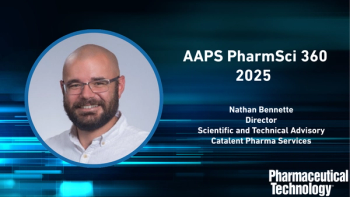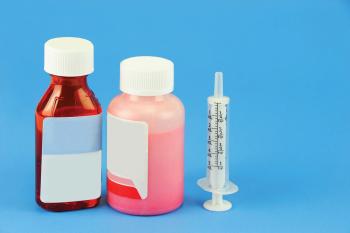
- Pharmaceutical Technology-10-02-2010
- Volume 34
- Issue 10
An Overview of NanoCluster Powder Formulation Technology
The authors describe a technique designed to yield low-density powders with a tailored particle-size distribution over a broad range of respiratory flow rates.
The lung is an excellent target for the delivery of drugs that treat local and systemic disorders because of its large surface area, good vascularization, thin alveolar epithelium, and capacity for solute exchange. The surface area of the lung is between 80 and 140 m2 . In peripheral pulmonary regions, the thickness of the alveolar epithelium is only 0.1–0.2 µm (1). In the deep lung (peripheral or alveolar region), the distance between the epithelial surface and the blood is 0.5–1.0 µm, which is much less than in the bronchial regions, where the distance between the mucus surface and blood is 30–40 µm (2). Thus, pharmaceuticals deposited in the peripheral region of the lung can be absorbed rapidly and are not subject to hepatic first-pass metabolic effects after their absorption.
The ability to consistently manufacture inhalation powders with customized particle size and aerodynamic properties is crucial to the advancement of effective medications that treat local pulmonary diseases, and to the delivery of systemic medications through the lung. To target deposition in various regions of the respiratory tract, including the deep lung, inhalation powders must have the appropriate particle size and aerodynamic characteristics, be therapeutically effective, be chemically and physically stable, and be compatible with current modes for pulmonary delivery. The ideal particle size for deposition into the deep lung is 1–3 µm (3–5). Particles with diameters of 4–5 µm typically deposit in the upper airways, regardless of whether they are dry particles or droplets, as nebulized formulations are (6, 7). For inhalation powders, particle size is not the only characteristic that guides deposition to a particular region of the lung. The mass median aerodynamic diameter (MMAD) has a greater influence on the deposition profile than particle size because it accounts for particle density and shape.
Current particle-size reduction technologies typically yield particles with MMADs in the range of 3–5 µm. However, the ability to create particles in the 1–3-µm range that target the peripheral lung provides opportunities to improve medications for diseases such as asthma and chronic obstructive pulmonary disease. Particle-size reduction techniques generally are categorized as milling from larger particles (i.e., top-down) or precipitation from solution (i.e., bottom-up).
Milling has been the traditional method for particle-size reduction. Various models such as ball mills, colloid mills, hammer mills, and jet or fluid-energy mills have been studied, but the majority of inhalation powders are prepared with jet mills. Jet milling has disadvantages that include the lack of control over parameters such as size, shape, morphology, and surface properties of the milled particles. In addition, the high energy input can promote chemical degradation and often damages the crystal surface, thus yielding highly charged and cohesive particles.
Precipitation techniques include spray drying, spray freeze-drying, supercritical-fluid extraction, and microcrystallization. Spray drying is a widely accepted pharmaceutical process that forces a fluid through a nozzle, thus generating a mist that is dried to produce a fine powder. Spray drying has been adapted to employ various nozzles that use ultrasound or air-jet shear to nebulize drug suspensions. Supercritical-fluid extraction uses a supercritical fluid, generally carbon dioxide, to extract a solvent from a drug emulsion or solution, thus leaving behind a suspension of drug particles. Both spray drying and supercritical-fluid extraction often use cosolvents to improve drying, require large amounts of excipients to stabilize the drug and powder properties, and require high shear rates that can denature proteins. The two processes typically have low yield efficiencies for particles smaller than 3 µm. Generally, these techniques produce inhalation powders that are blended with excipients or a carrier such as lactose.
Spray drying generates particles of an appropriate size for pulmonary delivery (8). Recently, spray-dried porous nanoparticle-aggregate particles (PNAPs), which are composed of a shell of nanoparticles and excipients, have exhibited an aerodynamic size of about 2 µm. Scientists have studied PNAPs for a range of applications from needle-free vaccine delivery to the delivery of antituberculosis compounds through the inhalation route (9, 10).
Another technique of aerosol generation for pulmonary delivery is thermal or condensation aerosols. Gupta et al. generated deoxycorticosterone, benzil, and phenyl-salicylate aerosols by a thermomechanical process without using propellants (11). The drug and excipients remained in a heated stainless-steel capillary for a short time, were vaporized, and condensed to form a low-velocity, drug-containing aerosol stream. The system can be configured to create various particle sizes from 1 to 5 µm, and even nanoparticles smaller than 100 nm (11, 12). In another approach to thermal aerosol generation, a solid thin film of a drug is vaporized under controlled heating conditions, and the vapor mixed with an air stream to form aerosol particles with a MMAD of 1–3 µm (13, 14).
Thermally generated aerosols depend upon the volatility of the drug substance. The drug substance should have high vapor pressure when heated so that it vaporizes off the surface before degrading. Degradation through drug pyrolysis or oxidation is a concern with thermally generated aerosols, but it can be mitigated by rapid heating and short exposure to the heating source. Temperature, heating rate, and airflow rate can be controlled electronically by incorporating circuits and sensors into the inhaler. Thus, these devices are more costly than most dry-powder inhalers, particularly for single-dose applications.
Savara Pharmaceuticals's (Austin, TX) NanoCluster technology yields low-density powders with a tailored particle-size distribution and an aerodynamic performance that is consistent over a broad range of respiratory flow rates. NanoCluster powders are produced using standard, commercially available processing equipment, thus offering a simple, scalable manufacturing process. NanoCluster powders have been prepared with less than 5% excipient and, in many cases, can be prepared without excipients.
Formulation
Formulation of particles in the 1–3-µm size range previously has required difficult approaches or complex delivery devices. In addition, such particles can be difficult to produce consistently and can require carrier particles because the micronized drug particles have poor flow characteristics. The only currently approved inhalation product capable of being delivered consistently as 1–3-µm particles is formulated for delivery by a pressurized metered dose inhaler (pMDI). In a pMDI, the active ingredient is dissolved or suspended in the propellant, and the interaction between the propelled liquid and aerosol valve determines the size of the delivered particle.
An example of such a drug product is Teva's (Petach Tikva, Israel) QVAR (beclomethasone). QVAR, with a particle size in the 1–3 µm range, consistently reaches the peripheral lung, thus providing an improved therapeutic outcome (15). In comparison, other products with the same active ingredient but with a particle size of 4–5 µm are unable to reach the distal airways (16). In addition, few technologies produce consistent and cost-effective inhalation powders suitable for delivering drugs to the peripheral lung using dry powder inhalers (DPIs) or nebulizers.
NanoCluster technology produces particles suitably sized and shaped for delivery to the distal airways through nebulizers, DPIs, and pMDIs without the need for carrier particles. The NanoCluster technology uses a bottom-up approach in which individual nanometer-sized drug particles are building blocks that form agglomerates with the desired MMAD (e.g., 1 µm for treating distal airways or 5 µm for treating upper airways). NanoClusters possess a micrometer-sized superstructure that comprises a nanosized substructure (see Figure 1). By agglomerating nanoparticles under controlled process conditions, scientists can give NanoClusters the desired physical and chemical characteristics. The literature describes solid-state characteristics, morphology, geometric particle size, and MMAD of various NanoCluster formulations (17–19). NanoClusters exhibit customizable aerodynamic sizes and excellent solubility by virtue of their relatively large surface area. In addition, the irregular shape of the NanoClusters decreases their contact area with device surfaces, thus resulting in superior flow properties.
Figure 1: The micrometer-sized superstructure of an example NanoCluster (Savara Pharmaceuticals, Austin, TX) is composed of nanosized substructures. ALL FIGURES ARE COURESTY OF THE AUTHORS.
Cascade-impaction studies have repeatedly demonstrated the aerodynamic performance of the NanoCluster technology using various formulations and active pharmaceutical ingredients, including steroids, beta-agonists, antihypertension drugs, antibiotics, and compounds to treat autoimmune diseases (17–21). Figure 2 shows the aerodynamic particle-size distribution results from cascade-impaction tests with a budesonide NanoCluster inhalation powder at different respiratory flow rates. These results demonstrate that the budesonide NanoCluster inhalation powder's aerodynamic performance and deposition is only minimally affected by airflow rate, an important characteristic for pharmaceuticals delivered with passive DPIs. Passive devices rely upon the patient's inhalation rate, which naturally varies from person to person. Consistent aerosol performance independent of inhalation rate is therefore highly desired, particularly for lung-compromised, elderly, and pediatric patients.
Figure 2: The influence of respiratory flow rate on the Aerodynamic particle-size distribution of the budesonide NanoCluster (Savara Pharmaceuticals, Austin, TX) inhalation powder. The authors used an Andersen cascade impactor at 25 °C and 45% relative humidity.
Manufacturing
High-performance particle-engineering technologies will not be actualized if they cannot be scaled into robust, repeatable, and cost-effective industrial processes. NanoCluster technology can be scaled up for industrial-quantity production. Unlike other particle technologies that require complex, expensive processing equipment to conduct a multistep manufacturing process, NanoCluster powders typically are produced through simplified manufacturing steps (see Figure 3). Active pharmaceutical ingredient powders are reduced to nanosized particles by well-established and accepted processes such as precipitation or mechanical methods such as media milling. In the postprocessing agglomeration approach shown in Figure 3, the nanoparticles are discharged into a tank to form a quasi-stable colloid before agglomeration. Agglomeration can be accomplished through several methods, including the metered addition of a small amount of an excipient or the simple adjustment of processing parameters. NanoCluster formulations sometimes require little (<5%) or no excipient to achieve the desired product characteristics.
Figure 3: Flow chart of the NanoCluster (Savara Pharmaceuticals, Austin, TX) manufacturing process.
In-processing agglomeration is another approach for controlling agglomeration during the production of NanoCluster particles. With this approach, the nanoparticle creation and agglomeration occur simultaneously, obviating the need to form a nanoparticle suspension. As soon as a small nanoparticle is broken off of a larger particle through attrition, the nanoparticle adheres to another nanoparticle. A significant benefit of this process is that it removes the need for excipients in the final formulation.
After nanoparticles agglomerate into micrometer-sized NanoClusters, operators remove the water used during the process through lyophilization or spray drying to yield low-density, high-performance powders. Further development work is currently underway to determine the technological and financial advantages of each drying method when forming NanoClusters with various active ingredients. Despite their small aerodynamic size, the NanoCluster formulations' physical characteristics make them suitable for downstream handling. Experience to date suggests that relatively few processing steps will be required to manufacture product at commercial scale. Standard powder-handling and -filling techniques suffice for packaging NanoCluster formulations into reservoir-type inhaler devices, capsules, or unit-dose blisters.
Device requirements
The particle size, shape, and performance characteristics of NanoCluster powders enable effective drug delivery through various inhalation devices. Several studies and evaluations have demonstrated that NanoCluster formulations provide emitted doses with high fine-particle fractions, even when delivered with simple, nonproprietary dry-powder devices such as the Monodose (Plastiape, Osnago, Italy), Turbuhaler (AstraZeneca, London), Easyhaler (Orion Pharma, Espoo, Finland), and Accuhaler (GlaxoSmithKline, London). When suspended in water and administered by nebulization, these formulations exhibit excellent delivery performance (see Figure 4). Studies with NanoCluster formulations delivered through pMDIs are currently ongoing to confirm the formulations' performance in this device class. The NanoCluster technology reduces the need for complex, expensive delivery devices to achieve repeatable aerosol delivery appropriate for deep lung deposition.
Figure 4: Comparison of Pulmicort Respule (AstraZeneca, London) and budesonide NanoCluster (Savara Pharmaceuticals, Austin, TX) performance by the LC Plus nebulizer (PARI, Midlothian, VA). The authors used an Andersen cascade impactor with a rate of 30 L/min at 25 °C and 45% relative humidity.
Conclusions
Savara's NanoCluster technology enables high-performance powder formulations that offer the opportunity to improve the performance of inhalation products significantly for local and systemic therapy. NanoCluster manufacturing processes are not complex and use common equipment and accepted pharmaceutical processes. NanoCluster formulations help companies optimize the aerodynamic properties of drug products, reduce the need for complex delivery devices, and improve safety and, potentially, efficacy. The relative simplicity and adaptability of the NanoCluster technology provides a cost-effective formulation platform that can shorten the development timelines of inhalation products.
Cory Berkland* is an associate professor of chemical and petroleum engineering and of pharmaceutical chemistry at the University of Kansas, 4141B Learned Hall, 1530 W. 15th St., Lawrence, KS 66045, tel. 785.864.1455, fax 785.864.4967,
*To whom all correspondence should be addressed.
Submitted: Sept. 24, 2009. Accepted: Feb. 1, 2010.
References
1. J.S. Patton and P.R. Byron, Nat. Rev. Drug Discov. 6 (1), 67–74 (2007).
2. G. Scheuch et al., Adv. Drug Deliv. Rev. 58, 996–1008 (2006).
3. N. Rasenack, H. Steckel, and B.W. Muller, J. Pharm. Sci. 92 (1), 35–44 (2003).
4. M.J. Telkoand and A.J. Hickey, Respir. Care 50, 1209–1227 (2005).
5. C.J. Musante et al., J. Pharm. Sci. 91 (7), 1580–1590 (2002).
6. M. Sakagami, Adv. Drug Deliv. Rev. 58, 1030–1060 (2006).
7. T.M. Crowder et al., Pharm. Res. 19 (3), 239–245 (2002).
8. J.C. Sung, B.L. Pulliam, and D.A. Edwards, Trends Biotechnol. 25 (12), 563–570 (2007).
9. Y.L. Wong et al., Proc. Natl. Acad. Sci. U.S.A. 104, 2591–2595 (2007).
10. J.C. Sung et al., Pharm. Res. 26 (8), 1847–1855 (2009).
11. R. Gupta et al., Aerosol Sci. Technol. 37 (8), 672–681 (2003).
12. X. Li et al., Int. J. Pharm. 303 (1–2), 113–124 (2005).
13. J.D. Rabinowitz, J. Pharmacol. Exp. Ther. 309 (5), 769–775 (2004).
14. R. Damani et al., 15th International Congress of the International Society for Aerosols in Medicine (Perth, Australia, 2005).
15. L. Kemp et al., J. Allergy Clin. Immunol. 123 (3), 729 (2009).
16. E. Derom and R.A. Pauwels, Clin. Pharmacokinet. 44 (8), 815–836 (2005).
17. L. Shi, C.J. Plumley, and C. Berkland, Langmuir 23 (22), 10897–10901 (2007).
18. N. El-Gendy et al., J. Pharm. Sci. 98 (8), 2731–2746 (2009).
19. C. Plumley et al., Int. J. Pharm. 369 (1–2), 136–143 (2009).
20. N. El-Gendy and C. Berkland, Pharm. Res. 26 (7), 1752–1763 (2009).
21. L.J. Peek, L. Roberts, and C. Berkland, Langmuir 24 (17), 9775–9783 (2008).
Articles in this issue
over 15 years ago
This Again?over 15 years ago
Risk Mitigation in High-Potency Manufacturingover 15 years ago
The Direction of Injectable Drug Deliveryover 15 years ago
Needles' Days Are Numberedover 15 years ago
Report from Europeover 15 years ago
Buyers in Short Supplyover 15 years ago
In the Spotlight October 2010over 15 years ago
An Unfocused Handbook on Environmental Monitoringover 15 years ago
Vaccine Manufacturing RebornNewsletter
Get the essential updates shaping the future of pharma manufacturing and compliance—subscribe today to Pharmaceutical Technology and never miss a breakthrough.




